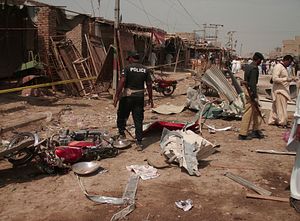Pakistan’s economic resurgence seems to be looming large. Trade through the China-Pakistan Economic Corridor has partially begun, further upping the excitement surrounding the $50 billion megaproject. But what does this mean for the impoverished province of Balochistan? After all, despite being home to Gwadar port, the crown jewel of CPEC, the province’s share in the CPEC bounty is a mere 0.5 percent.
Balochistan is undoubtedly in need of an economic lifeline. The metrics paint a dire picture for its residents: 70 percent of people in Balochistan live in poverty. In Balochistan, there are about 1.8 million children not attending school, which is perhaps related to the fact that more than 5,000 public schools in the region consist of nothing more than a single room. Health indicators are equally bad. The maternal death rate in Pakistan is 278 per 100,000, whereas in Balochistan it stands at 785 out of every 100,000. Almost 15 percent of the people of Balochistan suffer from Hepatitis B or C. Added to this, there’s an acute water shortage. These appalling statistics cut a sorry figure.
Yet with all the talk of CPEC being a game-changer for the country, the Balochs are still left waiting on the sidelines. Worse, the division of CPEC benefits repeats a long-standing pattern where the people of Balochistan are not allowed to benefit from the province’s own advantages. Natural gas was discovered at Sui in Balochistan, yet major parts of the province are still deprived of natural gas. Now Balochistan’s beneficial geography – namely, Gwadar port – might be used to enrich other provinces. Pakistani authorities must ensure that CPEC doesn’t repeat the earlier injustice meted out to the native Balochs. Balochistan must get its fair share of the economic corridor. Otherwise, faced with extreme poverty and disconsolate social indicators, the local people aren’t left with many options other than taking up arms.
Indeed, most of the insurgent movements in Balochistan have been linked with a sense of deprivation and underdevelopment. The people of Balochistan, as indicated, have been living in miserly conditions for too long. CPEC appeared to be a ray of hope. If that too fails to impact their lives for the better, the possibility of a full-on civil war, akin to that waged by the LTTE in Sri Lanka, can’t be ruled out.
Balochistan has been teetering on the brink of collapse for many years. Since 2003, there have been 817 deaths caused by suicide attacks in Balochistan, with more than 1,600 people severely injured. Sectarian outfits also continue to roam around freely in Balochistan. Since 2009, more than 760 people have been killed in sectarian clashes.
The Pakistani government and military officials tend to blame the violence in Balochistan on Indian meddling in the province. Predictably, Indian Prime Minister Narendra Modi’s remarks on Balochistan last year resulted in a lot of outcry in Pakistan. But playing the “India card” all the time won’t assuage the grievances of the Balochs. Conspiracy theories might be lucrative and have the potential to unite the jingoists under one banner, but the Baloch people will still be suffering the most. To truly solve the problems in Balochistan, Pakistan’s focus must be inward.
Balochistan has historically been mired in conflicts that have shaken the security apparatus from within. It’s important to understand that the violence in Balochistan is not just a question of terrorist safe havens; the insurgents are, to a large extent, local people longing for their constitutional rights and welfare.
There are, primarily, three sub-nationalist groups operating in Balochistan: the Balochistan Liberation Army (BLA), Baloch Republican Army (BRA), and Baloch Liberation Front (BLF). Pakistan’s government has generally regarded Brahamdagh Bugti, the alleged leader-in-exile of the BRA, as the sole representative of the Baloch conflict, particularly pointing to Bugti’s India-centric policy. This is the wrong approach; Bugti is one part of, and not necessarily representative of, a much larger picture.
Going forward, Pakistan should implement two changes to its current approach.
First, the state needs to de-hyphenate sub-nationalists from the terrorist outfits operating from within Balochistan. Organizations like Jamaat al Ahrar, Lashkar-e-Jhangvi, and Jundullah pose a terrorist threat to the country. These need to be dealt with accordingly as per the national counterterrorism strategies. Sub-national groups, on the other hand, should be encouraged to come into the national fold by addressing legitimate concerns. If the violence still gets out of hand, then counter-insurgency (COIN) strategies can be employed. Such a minor tweak in Pakistan’s warfare policy could have a big impact.
Second, Pakistan’s Baloch policy should no longer be shrouded in mystery. If someone is guilty of conniving with non-state actors, including operatives from other countries, then he or she should be subject to normal court proceedings. The ever-growing number of “missing persons” will only lead to more mistrust toward the central government. Media coverage in the region should also be ramped up, rather than the current situation of reporters going missing from Balochistan. Even a bit of transparency could take the region to new heights.
For now, if the current conditions hold, the world will just have to wait and see whether Balochistan can weather the storm. This time, thanks to CPEC, the choices for economic progress in the region are plentiful – but the results will depend on what policy Pakistan has in the offing. For the people of Balochistan, hope springs eternal.
Shazar Shafqat is an independent researcher and a security analyst. His work is regularly featured in the Middle East Eye, World Policy Journal, Asia Times, The Nation, Daily Times, and more.

































